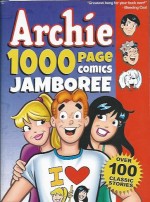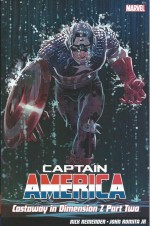
By many and various (Archie Comics)
ISBN: 978-1-936975-80-8
Win’s Christmas Gift Recommendation: the Holidays all wrapped up in one big book… 10/10
Following the debut of Superman, MLJ were one of many publishers to jump on the “mystery-man†bandwagon, concocting their own small but inspired pantheon of gaudily clad crusaders. In November 1939 they launched Blue Ribbon Comics, promptly following up with Top-Notch and Pep Comics. The content was the standard mix of masked champions, two-fisted adventurers, prose pieces and gags.
Not long after, Maurice Coyne, Louis Silberkleit and John Goldwater (hence MLJ) saw a gap in the blossoming but crowded market and in December 1941 the Fights ‘n’ Tights, He-Man crowd were gently nudged aside by a far from imposing hero, an ordinary teenager who would have ordinary adventures just like the readers, but with the laughs, good times, romance and slapstick emphasised.
Goldwater developed the concept of a youthful everyman protagonist and tasked writer Vic Bloom & artist Bob Montana with the job of making it work and, inspired by the popular Andy Hardy movies, their new notion premiered in Pep Comics #22. The unlikely star was a gap-toothed, freckle-faced red-headed kid obsessed with impressing the pretty blonde next door.
A 6-page untitled tale introduced hapless boob Archie Andrews and wholesomely pretty Betty Cooper. The boy’s unconventional best friend and confidante Jughead Jones also debuted in the first story as did idyllic small-town utopia Riverdale. It was a huge hit and by the winter of 1942 the kid had won his own title. Archie Comics #1 was MLJ’s first non-anthology magazine and with it began a slow transformation of the entire company. With the introduction of ultra-rich, raven-haired Veronica Lodge, all the pieces were in play for the industry’s second Genuine Phenomenon…
By 1946 the kids were in charge, so MLJ became Archie Comics, retiring most of its costumed characters years before the end of the Golden Age and becoming, to all intents and purposes, a publisher of family-friendly comedies. The hometown settings and perpetually fruitful premise of an Eternal Romantic Triangle – with girl-hating best bud Jughead and scurrilous rival Reggie Mantle to test, duel and vex our boy in their own unique ways, the scenario was one that not only resonated with the readership but was infinitely fresh…
Archie’s success, like Superman’s, forced a change in content at every other publisher (except perhaps Gilberton’s Classics Illustrated) and led to a multi-media brand which encompassed TV, movies, newspaper strips, toys and merchandise, a chain of restaurants and, in the swinging sixties, a pop music sensation when Sugar, Sugar – from the animated TV cartoon – became a global smash.
Clean and decent garage band “The Archies†has been a fixture of the comics ever since…
Archie is good-hearted, impetuous and lacking common sense, Betty his sensible, pretty girl next door who loves the ginger goof, and Veronica is rich, exotic and glamorous: only settling for our boy if there’s nobody better around. She might actually love him too, though. Archie, of course, is utterly unable to choose who or what he wants…
The unconventional, food-crazy Jughead is Mercutio to Archie’s Romeo, providing rationality and a reader’s voice, as well as being a powerful catalyst of events in his own right. That charming triangle (and annexe) has been the rock-solid foundation for seven decades of funnybook magic. Moreover the concept is eternally self-renewing…
This perennial eternal triangle has generated thousands of charming, raucous, gentle, frenetic, chiding and even heart-rending humorous dramas ranging from surreal wit to frantic slapstick, with the kids and a constantly expanding cast of friends (boy genius Dilton Doily, genial giant jock Big Moose and aspiring comicbook cartoonist Chuck amongst many others), growing into an American institution and part of the American Cultural landscape.
The feature has thrived by constantly refreshing its core archetypes; seamlessly adapting to the changing world outside its bright, flimsy pages, shamelessly co-opting youth, pop culture and fashion trends into its infallible mix of slapstick and young romance.
Each and every social revolution has been painlessly assimilated into the mix and over the decades the company has confronted most social issues affecting youngsters in a manner both even-handed and tasteful.
Constant addition of new characters such as African-American Chuck and his girlfriend Nancy, fashion-diva Ginger, Hispanic couple Frankie and Maria and spoiled home-wrecker-in-waiting Cheryl Blossom contribute to a wide and refreshingly broad-minded scenario. In 2010 Archie jumped the final hurdle when openly gay Kevin Keller became an admirable advocate capably tackling and dismantling the last major taboo in mainstream kids comics.
As well as forward thinking in content, the company was always quick to embrace innovations in format and Archie 1000 Page Comics Jamboree is another awesome but enjoyable paper brick of comics: pocket-digest-sized (as long as your pockets are both deep and strong), containing over 100 full-colour stories starring all the cast and characters. So fun-filled is this titanic tome that I’m again compelled to compromise my principles with a rather truncated and abbreviated review…
With so much to read in this mammoth, meaty, mirth-filled monolith it might seem that by specifically mentioning a few I’m saying some are better than others. That’s simply not so. They’re uniformly fabulous but there are only 24 hours in a day and my hands are old and increasingly feeble…
This Jamboree is especially timely as a goodly portion of the tales included here are Christmas episodes culled from the company’s wonderful archive of Seasonal classics: stories such as the epic ‘A Tree Grows in Riverdale’ and ‘The Last Resort’ by George Gladir, Stan Goldberg & Mike Esposito, ‘Santa’s Helper’ (inked by John Lowe) and Jughead’s typically unconventional reaction to ‘The Holiday Season’, illustrated by Tim Kennedy & Jim Amash.
There are surprises galore in store with vintage 1950’s tales from “the Vault†(including much spectacular and formative material from Archie’s Pals n’ Gals #4 by George Frese, Terry Szenics and Bill Vigoda plus covers reproductions in a selection entitled Archie’s Christmas Stocking…
Amongst the other Christmas treats Dick Malmgren & Jon D’Agostino give us ‘Here Comes Santa Clause’ and ‘Past-Present and Future’, Fernando Ruiz & Al Nickerson uncover an ‘X-Mas Mix-Up’, Frank Doyle & Vigoda relate ‘Not Even a Moose’, whilst Goldberg & Rudy Lapick investigate ‘The Swinging Santa’, Betty & Veronica are ‘Treed’ by Sugar Plum the Christmas Fairy (Kathleen Webb, Jeff Shultz & Al Milgrom) and enjoy a ‘Label Lullaby’ thanks to Gladir, Dan DeCarlo & Lapick, after which Al Hartley & D’Agostino unleash the ‘Holiday Joy-Boy’…
It’s not just a cool Yule rule though, and amongst the torrent of long tales, short stories, spoofs, parodies, ½ and single page gags, fashion pages, games, puzzles and so much more are year-round comedies, fantasies and love stories plus genre tinted tales: sci fi shockers such as ‘The Teenage Bulk‘‘ and ‘Destination Riverdale’, spooky thrillers like ‘Chiller’, ‘Midnight Madness!’, ‘The Ghost of Spirit Lake’ and ‘Drawing on Experience’, captivating crime capers like ‘Monkey Seize’, ‘Four Wheels to Wickedness’ or ‘A Smashing Success’ and less-definable outrageous episodes such as ‘The Kissing Bandit’, ‘Flip-Flop’, ‘Culture Shock’, ‘Fame Game’, ‘Pie á la Mountain’ and ‘The Heavenly Body’…
Moreover the school faculty and families of our stars also feature heavily. Archie’s dad relives his own musically cool days in ‘Ol’ Sax’ (Gladir, Goldberg & Lapick), and you’d be amazed at the antics of the dubious dinner lady Miss Beazley in ‘The Pies Have It’ or the long-suffering Principal Mr. Weatherbee in ‘Flight of the Bumble!’ and ‘Just One of the Boys’…
There are also solo outings for Ginger Lopez in ‘Fit as a Fiddle’, Dilton in ‘Kiss and Tell’, Nancy in ‘A Cat’s Tale’ and even manic mutt Hot Dog in ‘Smart Pet Tricks’ and other stalwarts from the old gang.
With contributions from Bob Bolling, George Gladir, Bill Vigoda, Harry Lucey, Samm Schwartz, Bill Golliher, Stan Goldberg, Jim Ruth, Frank Doyle, Greg Ehrbar, Jon D’Agostino, Fernando Ruiz, Bob Smith, Joe Edwards, Bill Galvan, Angelo DeCesare, Susan Solomon, Al Milgrom, Henry Scarpelli, Al Hartley, Rich Margopoulos, Barbara Slate, Ed Berdej, Al Nickerson, Mike Esposito, Tim & Pat Kennedy, Holly G!, Greg Crosby, Chic Stone, Gene Colan, Hal Smith, Dan Parent, Jeff Shultz, Rudy Lapick, Kathleen Webb, Jim Amash, Mike Pellowski, Bob White, Doug Crane, Rich Koslowski, Craig Boldman, Rex Lindsey, Allison Flood, Dick Malmgren, a dynasty of DeCarlos and many more, this is a true gem of perfectly crafted all-ages fun.
This is another ideal book for you, your kids and grandparents to enjoy over and over again…
© 2013 Archie Comics Publications, Inc. All rights reserved.











